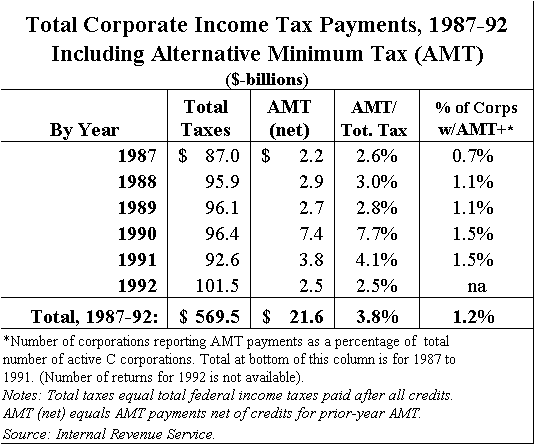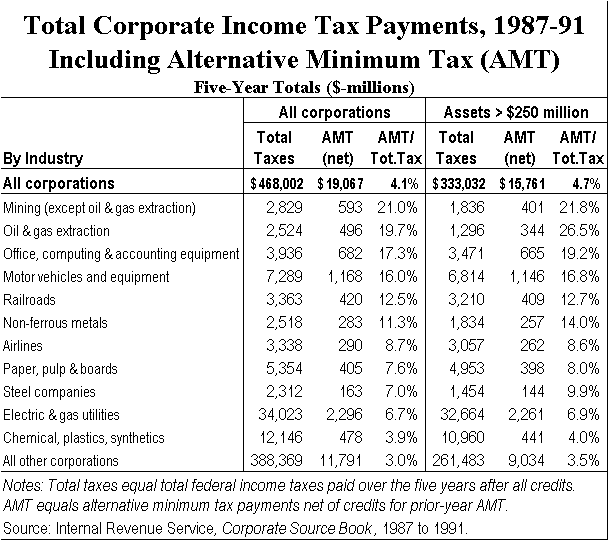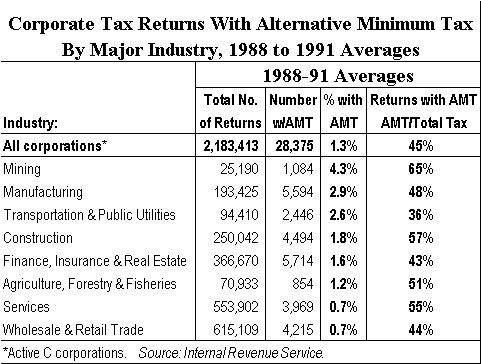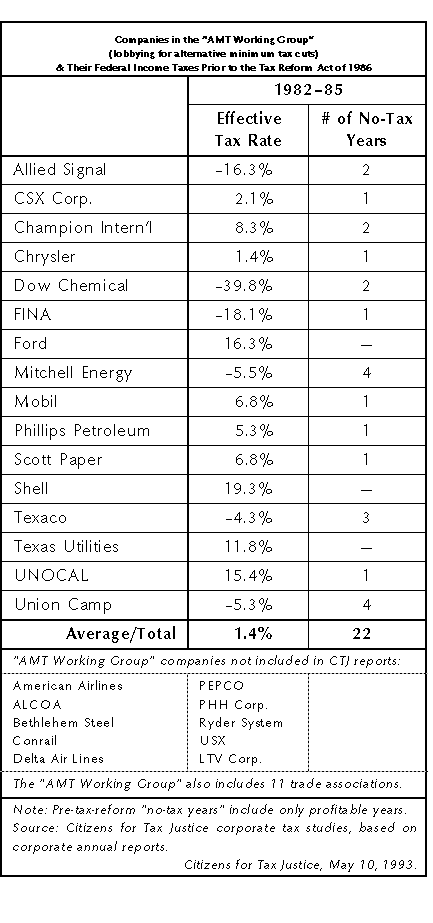May 3, 1995 04:46 PM | Permalink | ![]()
Click here to download this analysis in PDF format.
I appreciate the opportunity to testify before the Committee on behalf of Citizens for Tax Justice. Our coalition of labor, public interest and grassroots citizens groups represents tens of millions of middle- and low-income Americans, who have a vital stake in fair, economically sound tax and budget policies.
The issue before the Committee today involves the Alternative Minimum Tax, which was adopted in 1986 to try to put an end to the spectacle of highly profitable corporations and high-income individuals paying little or nothing in federal income taxes. Recently, however, the House has passed a bill that, among many other egregious provisions, would entirely repeal the Alternative Minimum Tax on corporations and gut the AMT as it applies to individuals.
The House plan is a direct attack on the principles of the 1986 Tax Reform Act. It could reasonably be called a slap in the face to Chairman Packwood, Sen. Bradley, former President Reagan, and all the others who worked so hard to pass the 1986 reforms. The designers of the House plan make no bones about the fact that they want to return to the bad old days of widespread corporate tax freeloading. We urge the Committee to reject the House’s outrageous AMT repeal proposal and instead to take measures to strengthen the minimum tax.
Why the Corporate Minimum Tax Was Adopted
A 1986 CTJ survey of 250 of the nation’s largest and most profitable corporations found that 130–more than half the total–managed to pay absolutely nothing in federal income taxes in at least one of the five years from 1981 to 1985.(1)
These 130 companies, ranging alphabetically from Aetna Life & Casualty to Xerox, earned a combined total of $72.9 billion in pretax domestic profits in the years they did not pay federal income taxes. But instead of paying $33.5 billion in income taxes, as the 46 percent statutory federal corporate tax rate purportedly required, they received $6.1 billion in tax rebates–for a “negative” tax rate of -8.3 percent.
- Of this group of 130 corporate tax freeloaders, 73 had at least two years of paying nothing in federal income taxes from 1981 to 1985.
- 42 of these companies paid nothing–or less–in total federal income taxes over the entire five years.
Congress rightly found this situation intolerable. “The committee believes the tax system is nearing a crisis point,” said the December 1985 House Ways and Means Committee Report on what became the Tax Reform Act of 1986. “Many firms have made use of tax provisions to reduce their tax liability to zero, and, in some cases corporations with substantial book income obtain tax refunds.”
Likewise, the Senate Finance Committee’s May 1986 report on the same bill stated: “The committee finds it unjustifiable for some corporations to report large earnings and pay significant dividends to their shareholders, yet pay little or no taxes on that income to the government.”
In response to the egregious level of corporate tax avoidance, the Tax Reform Act of 1986 closed many business loopholes and adopted the Alternative Minimum Tax. The AMT was designed to assure that all profitable corporations pay at least some reasonable amount in federal income tax. The official summary of the Tax Reform Act of 1986 states:
“Congress concluded that the minimum tax should serve one overriding objective: to ensure that no taxpayer with substantial economic income can avoid significant tax liability by using exclusions, deductions, and credits. . . . It is inherently unfair for high-income taxpayers to pay little or no tax due to their ability to utilize tax preferences.”
The Structure of the Alternative Minimum Tax
The “alternative” feature of the AMT works like this. Most companies pay the 35 percent regular corporate tax rate on their profits less amounts sheltered by various remaining tax preferences, such as accelerated depreciation (200%-declining-balance over short periods) and special breaks for oil, gas and mining. Alternatively, companies must pay the 20 percent minimum tax on profits computed without some of the loopholes–if the AMT is higher.
Minimum taxable income is usually higher than regular taxable income for several reasons. Depreciation write-offs, for example, are less accelerated under the AMT. Investments in mining exploration and development must be amortized over 10 years rather than deducted immediately. And tax “losses” (NOLs) left over from prior years that are attributable to certain tax preferences (such as accelerated depreciation and a portion of certain oil tax breaks) cannot be used to offset the AMT.
In addition, if “adjusted current earnings” exceeds minimum taxable income as otherwise defined, then the AMT applies to three-quarters of the difference. In computing adjusted current earnings, certain tax preferences are further scaled back and tax “losses” from previous years are not allowed.(2)
How the Minimum Tax Has Worked in Practice
Since their adoption, the 1986 reforms, including the corporate Alternative Minimum Tax, have curbed many of the worst corporate tax avoidance problems. In fact, the number of no-tax giant corporations in CTJ’s last comprehensive survey (in 1989) dropped sharply–to only seven in 1988.(3) Although not all firms disclose in their annual reports whether they paid the minimum tax, in our 1987 corporate tax survey we were able to identify 11 profitable companies that would have paid no tax at all without the minimum tax.(4) As a 1991 IRS paper noted, “in the case of large companies with regular deferrals of tax liability, AMT may cause them to experience a new phenomenon: paying taxes.”(5)
 That’s not to say, however, that the Alternative Minimum Tax is paid by very many corporations. According to the IRS, from 1987 through 1991 the corporate AMT was paid by about 28,000 corporations a year–only 1.2 percent of all active corporate filers. By major industry, the percentage of corporations paying the AMT (in 1988-91) ranged from 4.3 percent in mining down to 0.7 percent in wholesale and retail trade.
That’s not to say, however, that the Alternative Minimum Tax is paid by very many corporations. According to the IRS, from 1987 through 1991 the corporate AMT was paid by about 28,000 corporations a year–only 1.2 percent of all active corporate filers. By major industry, the percentage of corporations paying the AMT (in 1988-91) ranged from 4.3 percent in mining down to 0.7 percent in wholesale and retail trade.
Overall from 1987 through 1992, the AMT directly increased total corporate income tax payments by a net of $21.6 billion. That’s only 3.8 percent of the total amount that corporations paid in income taxes over that period. As a share of taxes paid, the biggest direct tax effects from the AMT were in the historically low-tax mining and oil & gas extraction industries, where the AMT amounted to about a fifth of total income taxes paid from 1987 to 1991.
Some 83 percent of the total 1987-91 net AMT was paid by corporations with assets greater than $250 million. That’s noticeably more than 71 percent of total corporate income taxes (after credits) paid by these giant companies. The AMT’s share of total taxes on giant companies was 4.7 percent.

Corporate Complaints about the Minimum Tax
So if the AMT is paid by so few corporations and amounts to such a small share of total corporate income tax payments, why is there so much corporate complaining about the AMT? There are two primary reasons:
First of all, the most important effect of the AMT is not the revenues it directly produces, but the tax avoidance that it stops in the first place. In other words, without the AMT corporations would find it profitable to engage in a plethora of economically wasteful tax avoidance activities that they now eschew in favor of productive endeavors. For example, it would be easier for companies to buy and sell excess tax write-offs. Oil companies would use loopholes they now sometimes forego. Insurance companies and banks would shift into more tax-exempt debt. That’s why the official Joint Tax Committee estimates of the cost of the House-passed AMT repeal–about $3 billion a year–are ridiculously low. In truth, if the House measure were enacted, the actual revenue cost would be at least three times those official estimates.
Second, direct AMT payments are a big deal for the few companies that actually pay the AMT. Overall, the AMT amounted to about 45 percent of the income taxes paid by the few corporations that paid it in 1988 through 1991 (in the years that they paid the AMT). Without the AMT, those corporations that paid it would have had very low, or even zero effective tax rates, as the examples further on in this testimony illustrate. 
Corporations who favor eliminating the AMT contend that it has caused dire problems for the companies affected, raising their “cost of capital” and hurting their ability to compete internationally. But this argument verges on being silly. The AMT rate is only 20 percent–far below the corporate tax rate in any other major Western nation. Indeed, the regular U.S. corporate tax rate of 35 percent is also below the rate in most other countries. How can paying taxes at a 20 percent rate (or a 35 percent rate, for that matter) put American companies at a disadvantage compared to foreign corporations that generally pay much higher tax rates?
The United States already has very low corporate income taxes by international standards. In fact, at only 2.3 percent of gross domestic product (from 1989 to 1991), U.S. federal and state corporate income taxes are 40 percent below the 3.8 percent of GDP weighted average for the 22 other OECD nations. Japan’s corporate income taxes, for example, were 6.8 percent of GDP in 1989-91, the United Kingdom’s were 3.9 percent of GDP, and Canada’s were 2.6 percent.
It’s very hard to believe that the AMT–a low-rate tax that directly affects only one percent of all corporations and directly raises only a few billion dollars a year–could possibly be guilty of the crimes it is alleged to perpetrate. Instead, the AMT actually works to level the business playing field, avoiding the inevitable economic distortions that result when certain industries and companies enjoy low-tax status, while others must pay significant taxes.
Notably, after the 1986 Tax Reform Act was adopted, business investment picked up markedly from its weak performance over the 1981-86 loophole era. Real business investment grew by 2.7 percent a year from 1986 to 1989, 42 percent faster than the meager 1.9 percent annual growth rate from 1981 to 1986. Leading the way was a resurgence in investment in industrial plant and equipment, which grew rapidly after actually falling from 1981 to 1986.
 Some companies complain that the AMT can be tough on them in bad years. For example, suppose a company “normally” makes $500 million in pretax profits, and that after various special tax write-offs, its taxable income is $250 million. Such a company would “normally” pay 35 percent of that, or $88 million, in regular taxes–a 17.5% effective tax rate that would be unlikely to trigger the alternative minimum tax. But should the company’s pretax profit temporarily fall to, say, only $250 million (due to an short-term downturn in sales), while its special tax write-offs remained constant, then its taxable income would go to zero, and the AMT would probably be triggered.
Some companies complain that the AMT can be tough on them in bad years. For example, suppose a company “normally” makes $500 million in pretax profits, and that after various special tax write-offs, its taxable income is $250 million. Such a company would “normally” pay 35 percent of that, or $88 million, in regular taxes–a 17.5% effective tax rate that would be unlikely to trigger the alternative minimum tax. But should the company’s pretax profit temporarily fall to, say, only $250 million (due to an short-term downturn in sales), while its special tax write-offs remained constant, then its taxable income would go to zero, and the AMT would probably be triggered.
Why this is perceived to be a problem, however, is hard to understand. After all, the company in this example still earned $250 million, and the approximately 10 percent tax that it would be likely to pay under the AMT hardly seems excessive. Moreover, assuming that the company returns to its “normal” profitability in subsequent years, it will get a credit for the AMT it paid.
Thus, as the real world evidence outlined in the next section of this testimony (and appendix 1) illustrates, the primary corporate complaints about the AMT come from companies that absent the AMT would pay little or nothing in federal income taxes year in and year out. Such companies simply don’t want to pay federal income taxes, hardly a sympathetic position.
The sometimes ludicrous nature of the corporate complaints about the AMT were inadvertently illustrated in a recent series of Mobil Corp. advertorials, which bemoan the fact that under the regular tax, a steel mill can be written off over 7 years, but under the AMT the write-off period is 15 years. How long does Mobil think a steel mill actually lasts?
Finally, some academic economists have argued that in a perfect world, we would not need an alternative minimum tax. It would be preferable, they say, if the regular tax were improved by closing the loopholes whose excesses the AMT is designed to curb. Maybe so, but the choice on the table today is not whether we should reform the regular tax rather than keeping the AMT. Instead, it is whether, an admittedly imperfect regular tax system needs an AMT backup to curb abuses. The AMT may be only a second-best solution to corporate tax avoidance, but that’s far better than no solution at all. In addition, academic economists who argue that we should have “one set of tax rules for everyone” ignore the complicated real world we live in–where one size does not always fit all. For example, current accelerated depreciation rules may provide “only” a significant subsidy for equity-financed corporate investment. But in the case of even partially debt-financed investments, the regular depreciation rules can often lead to outright negative tax rates. Thus, we need a backup AMT, with (among other things) less generous depreciation allowances, to deal with those cases where even generally “reasonable” tax rules lead to subsidies that are far, far larger than anyone would want them to be.
A Return to the Days of Corporate Tax Freeloading?
At bottom, the real purpose of various proposals to weaken the minimum tax has nothing to do with sound economics. As Ways and Means Chairman Bill Archer (R-Tex.) has happily admitted, the result of the House alternative minimum tax repeal would be to allow some highly profitable companies “to pay no tax.” He’s right. If Congress weakens the minimum tax by restoring tax preferences, it can be confidently predicted that the specter of large, profitable “no-tax corporate freeloaders” will return.
In particular, some of the companies that are lobbying hardest for repeal of the minimum tax paid very low–or no–federal income taxes prior to adoption of the Alternative Minimum Tax, and even today they pay low effective rates.
CTJ’s previous corporate tax reports covering 1982 to 1985 include 16 of the 26 corporate members of a so-called “AMT Working Group,” which was set up in 1993 to lobby for reductions in the corporate minimum tax. Over those four pre-tax-reform years, the average effective federal income tax rate on these 16 companies was a minuscule 1.4%. As a group, the 16 companies enjoyed a total of 22 no-tax (but profitable) years from 1982 to 1985.
- Thirteen of the 16 companies enjoyed at least one year from 1982 to 1985 in which they paid nothing (or less) in federal income taxes (despite considerable profits). Six companies enjoyed multiple profitable no-tax years.
- Six of the 16 companies paid a total of less than nothing in federal income taxes over the four years prior to tax reform.
- Only 4 of the 16 companies paid more than 10 percent of their profits in federal income taxes from 1982 to 1985.
 More recent corporate annual reports from some of the “AMT Working Group” members show the effects of the current Alternative Minimum Tax. Many of them would pay nothing at all in federal income taxes without the corporate minimum tax. For example:
More recent corporate annual reports from some of the “AMT Working Group” members show the effects of the current Alternative Minimum Tax. Many of them would pay nothing at all in federal income taxes without the corporate minimum tax. For example:
- In 1992, Texas Utilities paid a total of $19.6 million in federal income taxes on its $1 billion-plus in profits (for an effective rate of 1.9%). Without the AMT, Texas Utilities would have received a tax rebate of at least $18 million in 1992. The AMT also accounted for all the taxes paid by Texas Utilities in 1991 and 1990.
- In 1991 and 1992, FINA received tax rebates totaling $12.6 million on top of its $73 million in pretax profits. But without the AMT, FINA’s 1990-91 tax rebates would have been at least $8.2 million larger.
- In 1991, Union Camp paid $35.8 million in federal income tax on its $185 million in profits (an effective rate of 19.4%). Without the AMT, Union Camp not only would have paid no tax, but would have received an outright tax rebate of at least $3.7 million in 1991. In addition, the AMT cut Union Camp’s tax rebate in 1992 from $52.9 million to “only” $37.2 million.
- The AMT was the only reason why Champion International paid any federal income tax on its $346 million in 1990-91 profits. Without the AMT, Champion would have received $48.6 million in tax rebates over the two years. Champion paid only about 2% of its profits in federal income taxes from 1981 to 1987.
- From 1987 to 1991, the AMT accounted for all of the federal income taxes paid by Mitchell Energy Corp. Without the AMT Mitchell would have paid no federal income tax at all in each of those five years (as it did from 1982 to 1985), and would have received outright tax rebates in some years. In 1992, the AMT accounted for more than half of Mitchell’s federal income tax payment.
- LTV Corporation paid a 14.6 percent effective federal tax rate in 1990 and only 4.1 percent in 1989, most or all of which, according to LTV’s annual report, was the Alternative Minimum Tax.
- After paying no federal income taxes at all in the early 1980s, Texaco has been paying some tax in recent years. In 1993, however, Texaco’s federal income tax bill was only $5 million on $383 million in U.S. profits–an effective tax rate of only 1.3%.
We don’t need to lower taxes even further on these companies or others that pay the AMT in order to compete in world markets. On the contrary, the fact that these and other companies pay such low effect tax rates suggests that the AMT needs to be strengthened, not repealed. If the abuses that the minimum tax was designed to stop are recreated, the cost to the Treasury will be substantial, and taxpayer confidence in the integrity of the federal tax system will be damaged. It will then become even more difficult to raise the revenue the government needs to reduce the budget deficit and address our nation’s other problems. And if Congress fails to deal with those issues, the damage to American business and our ability to compete internationally will be severe.
We urge the Congress to reject efforts to weaken the corporate Alternative Minimum Tax, and instead to take steps to strengthen this important feature of our tax system.
AMT Reform Options
Although adoption of the corporate Alternative Minimum Tax was an important step in the direction of tax fairness, further reforms are still needed.
To make the Alternative Minimum Tax more effective, more loopholes and tax preferences should be disallowed in computing Alternative Minimum Taxable Income. Examples of changes that could be made to strengthen the corporate Alternative Minimum Tax include:
- Change accelerated AMT equipment depreciation to straight line over ADR lives.
- Treat all oil & gas intangible drilling cost deductions in excess of 6-year amortization as a tax preference.
- Disallow AMT deductions for business meals & entertainment.
- Disallow write-offs for “company cars” (with minor exceptions).
- Disallow interest deductions for payments to foreign lenders in tax havens. (This is a back-door compliance reform).
- Increase the corporate AMT rate from the current 20 percent rate, so that it is closer to the 28% individual AMT rate.



